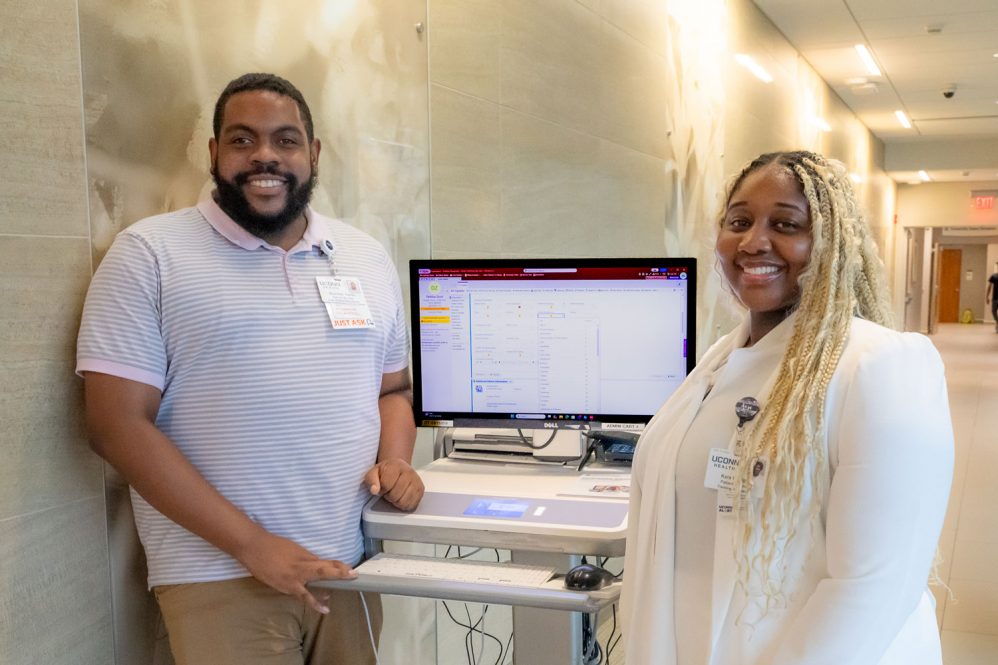UConn Health has updated its health care forms to include expanded options for race, ethnicity, and language (REL), aiming to better reflect its diverse patient population. This update now offers more options, allows patients to select more than one choice, and includes an option to decline to answer.
REL information is a tool for improving health care quality and addressing patient disparities. Understanding a patient’s background and preferred language helps providers ensure clearer communication and deliver more personalized and quality care.
“We wanted to have the proper way of getting that information without inferring something to them what isn’t true, because it is very beneficial,” says Rebekah Normandeau, UConn Health director of patient access.
Within Epic, which is UConn Health’s electronic health record, is the patient portal MyChart. Patients using MyChart will see an important update when scheduling appointments. A new announcement titled “Serving You Better” appears while logging in, informing patients that expanded race and ethnicity options are available. While booking an appointment, patients can select from these added categories as part of the updated process.
“Our patients [previously] would self-identify, but it would only be with the five options, and they would say ‘I don’t really fit in any of these’ and so then you’re forcing them to pick in one widget or another,” says Ingrid Napoletano, UConn Health assistant vice president of IT clinical systems.
By implementing how race and ethnicity information is collected, REL can help prevent staff from making assumptions about a patient’s background. Instead of relying on appearance, staff members are trained to respectfully ask patients how they identify, promoting accurate self-identification.

Harmony Lipeika, a MyChart analyst, partnered with Lenore Reilly, an Epic analyst, to develop and test updates from both the patient MyChart side and the internal registration team’s perspective, working closely to constantly refine and test the changes until they were ready for implementation.
“The analysts and I spent time together building and testing and then talking together about when this goes into production, so that once everything was turned on, I could then activate that MyChart announcement,” says Lipeika.
This hands-on collaboration was essential to making sure both patient and staff facing systems function. By working in tandem, the team was able to make technical updates across platforms, anticipate questions, and adjust workflows. Their approach ensured a seamless experience for patients while giving registration teams the tools they needed to support this transition.
The goal of collecting REL data is to better understand social determinants of health and identify demographic patterns tied to specific health issues. Analyzing REL data with ZIP codes, staff can pinpoint disparities, target resources more effectively, and design interventions that address the needs of these communities.
The Yale School of Public Health played a key role in the implementation of a new Connecticut law aimed at improving racial and ethnic data collection in clinical settings. Through a series of meetings, the school helped bring together various health care providers to adopt updated practices. The law mandates more inclusive self-identification options for patients, allowing them to select multiple racial identities and specify detailed subcategories beyond the traditional options.
“It was new and exciting, people getting together, who had different clinical settings or none. They ended up breaking us down into different sub work groups to try to address different parts of what needed to be done, creating the training, creating the supporting language,” says Napoletano.
The collaboration made by these work groups allowed health care workers from a range of settings to contribute their expertise. Each group played an important role in shaping the final product. These contributions help build a diversified approach to REL data collection that can work across institutions, including UConn Health.
Significant challenges surfaced while implementing the new training, both in determining what was needed and how best to deliver it. Timing was another issue, as the updates had to align with live data being loaded into Epic. However, the update was delayed avoiding patient confusion, since staff preferred to communicate directly.
Staff will contact patients ahead of their appointments to update demographics and complete registration before arrival. New employees receive consistent training during onboarding, and if reports show that patients aren’t responding or the process is not working, additional support is provided. Trainees are walked through each step to ensure confidence and clear communication.
Looking ahead, Lipeika has scheduled the MyChart announcement to refresh in May 2026 as a reminder for patients to update their information. If the update proves to work, she plans to adjust the frequency, making the announcement annual or semi-annual to keep patients informed about their options.
The changes are intended as a step toward more personalized care. By expanding REL data collection and combining it with training and patient outreach, the system aims to create a more inclusive environment and provide a more respectful space for patient-centered care.



